Service Dogs and Therapy Dogs Help People with Disabilities and Special Needs
July 1, 2017Whether it’s alerting a diabetic owner to a drop in blood sugar; assisting with daily tasks for a physically disabled person; or bringing joy to the residents of a hospital or nursing home, service dogs and therapy dogs are bundles of unconditional love that are trained for a variety of tasks.
Different types of service dogs include guide dogs, hearing dogs, mobility dogs, medical detection dogs, psychiatric service dogs, and autism dogs. Therapy dogs and emotional support animals are another way dogs can be trained to help people.
The Difference Between Service Dogs and Therapy Dogs

Photo Credit: Sylvie Bouchard/123RF.com
There are very important distinctions and legal definitions between service dogs and therapy dogs. Service dogs are carefully trained to do things that their disabled partner is not able to do because of his or her disability. They are working dogs and not considered a “pet.” Therapy dogs as well as emotional support animals are not legally defined by the ADA. These support animals provide companionship, relieve loneliness, and can often help with depression and anxiety, but are not limited to working with people with disabilities.
Types of Service Dogs
Service dogs are legally defined by Title II and Title III of the Americans with Disabilities Act. According to the ADA: “A service animal means any dog that is individually trained to do work or perform tasks for the benefit of an individual with a disability, including a physical, sensory, psychiatric, intellectual, or other mental disability.”
Depending on the disability of their handlers, service dogs perform a variety of tasks such as retrieving dropped items, alerting to a sound, pressing an automatic door button, or reminding to take medications. Some examples of the types of service dogs under the ADA’s definition include:
- Guide Dog: used to guide people who have severe visual impairments or are legally blind.
- Hearing Dog: alerts a deaf or hearing-impaired person when a sound occurs, such as an alarm clock ringing or a knock on the door.
- Physical Disability Service Dog: assists people with a physical disability by performing tasks that their partner cannot do or has trouble doing, such as turning on and off light switches or retrieving dropped items.
- Psychiatric Service Dog: assists individuals with psychiatric disabilities, including Post Traumatic Stress Disorder, to detect the onset of psychiatric episodes and to help mitigate the effects.
- Sensory signal dog or social signal dog: helps an adult or child with autism.
- Seizure Response Dog: assists a person with a seizure disorder either by predicting a seizure and warning the person in advance or standing guard over the person during a seizure – or the dog may go for help.
Emotional Support Dogs and Therapy Dogs
Emotional support dogs are dogs that provide comfort and support for an individual suffering from various mental and emotional conditions. According to the United States Dog Registry, an emotional support dog is not required to perform any specific tasks for a disability like a service dog. They can assist with conditions such as anxiety, depression, bipolar disorder, mood disorder, panic attacks, phobias, and other psychological and emotional conditions.
A therapy dog is trained to provide affection and comfort to people in hospitals, retirement homes, nursing homes, schools, and hospices. Therapy dogs are often well-behaved pets that are given basic obedience training and then tested for both obedience and temperament. Once they pass a therapy dog test with their partner, they can be registered with a therapy dog organization, such as Dog B.O.N.E.S., which can help match them with the facilities they visit.
There are at least three different types of therapy dogs:
- Therapeutic Visitation Dogs: are household pets whose owners take time to visit hospitals, nursing homes, and rehabilitation facilities to lift their spirits and help motivate them in their therapy or treatment.
- Animal Assisted Therapy Dog: assists physical and occupational therapists in meeting goals important to an individual’s recovery. Animal Assisted Therapy dogs typically work in rehabilitation facilities.
- Facility Therapy Dog: primarily works in nursing homes and are often trained to help patients with Alzheimer’s disease. They live at the facility and are handled by a trained member of the staff.
You Can Help
There are many wonderful organizations that train service dogs such as Guiding Eyes for the Blind that train dogs to provide assistance for blind and visually impaired people and NEADS which provides training for a variety of service dogs, including hearing dogs, autism dogs, and physical disability dogs, among others. You can also check Handichelp which helps you live a better life with disability. These organizations often need volunteers to help train and socialize the puppies who are undergoing intensive training. They also depend on volunteers to help with operational tasks or donate funds. Please visit their websites for more information.
Leave a Comment